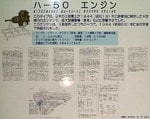- Thread starter
- #121
You are welcome, Aurum.
1. There is/was always prototype or experimental type before formal production.
Production period would have been different.
2. The page says Gnome Rhone sample was a copy of Bristol Jupitor clearly.
3. Page 66 attached says -
"It was a common knowledge at the time that idealistic stroke is 10% longer than bore diameter. Nakajima would have avoided the 190mm of Jupiter as it seemed too long. However, there was another possibility that Nakajima simply referred to the 6"3/8(161.9mm) of Hornet."
Even author does not know exactly.

1. There is/was always prototype or experimental type before formal production.
Production period would have been different.
2. The page says Gnome Rhone sample was a copy of Bristol Jupitor clearly.
3. Page 66 attached says -
"It was a common knowledge at the time that idealistic stroke is 10% longer than bore diameter. Nakajima would have avoided the 190mm of Jupiter as it seemed too long. However, there was another possibility that Nakajima simply referred to the 6"3/8(161.9mm) of Hornet."
Even author does not know exactly.


